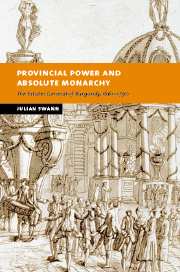Book contents
- Frontmatter
- Contents
- List of illustrations
- List of figures
- List of appendices
- List of map
- Preface
- List of abbreviations
- Map: The duchy of Burgundy in the eighteenth century
- 1 Historians, absolute monarchy and the provincial estates
- 2 Ancien régime Burgundy
- 3 The Estates General of Burgundy
- 4 Nosseigneurs les élus and the officers of the Estates
- 5 The provincial administration: authority and enforcement
- 6 ‘It's raining taxes’. Paying for the Sun King, 1661–1715
- 7 Provincial administration in an age of iron, 1661–1715
- 8 The limits of absolutism: crown, governor and the Estates in the eighteenth century
- 9 Provincial rivalries: the Estates and the Parlement of Dijon in the eighteenth century
- 10 Tax, borrow and lend: crown, Estates and finance, 1715–1789
- 11 An enlightened administration?
- 12 The coming of the French revolution in Burgundy, 1787–1789
- Conclusion
- Appendices
- Bibliography
- Index
4 - Nosseigneurs les élus and the officers of the Estates
Published online by Cambridge University Press: 05 July 2009
- Frontmatter
- Contents
- List of illustrations
- List of figures
- List of appendices
- List of map
- Preface
- List of abbreviations
- Map: The duchy of Burgundy in the eighteenth century
- 1 Historians, absolute monarchy and the provincial estates
- 2 Ancien régime Burgundy
- 3 The Estates General of Burgundy
- 4 Nosseigneurs les élus and the officers of the Estates
- 5 The provincial administration: authority and enforcement
- 6 ‘It's raining taxes’. Paying for the Sun King, 1661–1715
- 7 Provincial administration in an age of iron, 1661–1715
- 8 The limits of absolutism: crown, governor and the Estates in the eighteenth century
- 9 Provincial rivalries: the Estates and the Parlement of Dijon in the eighteenth century
- 10 Tax, borrow and lend: crown, Estates and finance, 1715–1789
- 11 An enlightened administration?
- 12 The coming of the French revolution in Burgundy, 1787–1789
- Conclusion
- Appendices
- Bibliography
- Index
Summary
With the Estates General in session for only a few weeks every three years, power and responsibility was devolved to its representatives and officers in the chamber of élus. No less an authority than Chrétien Guillaume de Lamoignon de Malesherbes, first president of the Cour des Aides of Paris and later an enlightened minister of Louis XVI, observed in the remonstrances he addressed to Louis XV in July 1763 ‘that as many disputes are settled and as much business conducted in this chamber of élus as in the most active intendance’. As rivals and fierce critics of the élus, Malesherbes and his colleagues sought to denigrate the Burgundian administration by maintaining that, despite their immense workload, ‘in reality the élus only assemble in Dijon once each year, that this assembly lasts for about two months and, in the intervals, there are no other meetings’. In their absence the daily administration ‘is necessarily handed over to subordinates who are permanently resident in Dijon’.
Despite the polemical tone of the remonstrances, which were written during a particularly bitter jurisdictional quarrel with the Estates, many subsequent historians have been happy to repeat these allegations as part of a more general critique of the competence and integrity of the élus. In his discussion of the province's fiscal system, Bouchard was unequivocal: ‘the élus of the clergy and the nobility played almost no role at all. The majority of the time, they resided in a monastery, a château or in another town than the capital of the province’.
- Type
- Chapter
- Information
- Provincial Power and Absolute MonarchyThe Estates General of Burgundy, 1661–1790, pp. 91 - 125Publisher: Cambridge University PressPrint publication year: 2003

